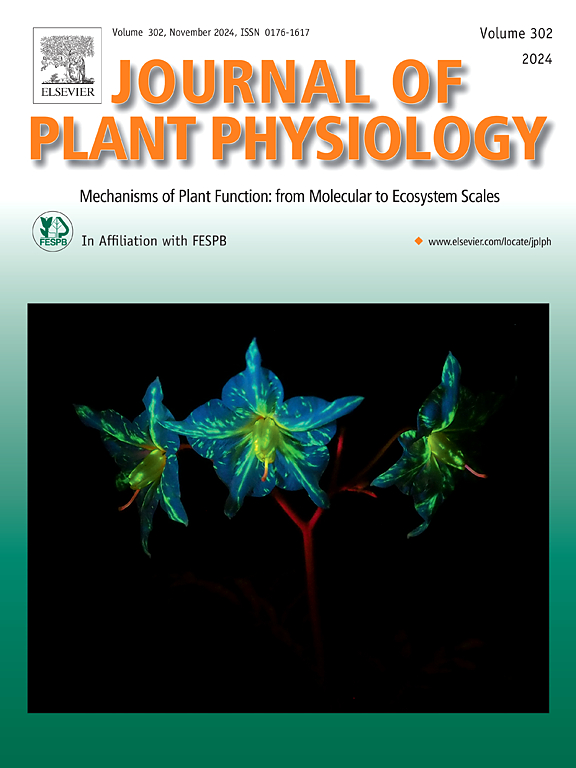Unveiling regional and altitudinal lipidomic analyte signatures of the argan tree (Argania spinosa L.) for environmental adaptation
IF 4.1
3区 生物学
Q1 PLANT SCIENCES
引用次数: 0
Abstract
Environmental factors such as altitude, precipitation, and temperature shape the lipidomic profiles of the argan tree (Argania spinosa L.), supporting its adaptation to stress. This study investigated lipidomic profiling and pathways in argan tree leaves from four altitudinal zones (A: low, B: moderate, C: high, D: very high) across three Moroccan regions (Chtouka Aït Baha, Essaouira, and Tiznit) using Gas Chromatography-Mass Spectrometry (GC-MS). The GC-MS workflow included a transmethylation step that cleaves ester bonds and acetylations, yielding analytes derived from diverse precursor lipids such as glycerolipids, sterol esters, and wax esters. We identified 139 lipid analytes, categorized into fatty acyls (53 %), prenol lipids (41 %), and steroids (6 %). Shared lipids across all zones highlight core metabolic pathways essential for resilience, while unique lipids reflect zone-specific adaptations. Fourteen known analytes were identified as critical markers for regional adaptations through multivariate analyses, including Principal Component Analysis (PCA), Partial Least Squares Discriminant Analysis (PLS-DA), and Variable Importance in Projection (VIP) scores. Among these, three analytes (methyl 18-methyleicosanoate, Z,Z-11,13-Hexadecadien-1-ol, and 11-Octadecenoic acid) showed the highest accumulation in Zone A, whereas eleven analytes (Henicosyl formate, Dodecyl 2-methylbutanoate, Methyl 21-methyl-hexacosanoate, Methyl 13-methyltetradecanoate, Cetoleic acid, (Urs-12-en-3-ol, acetate, (3.beta.)-), Medicagenic acid, 2-(4a,8-Dimethyl-6-oxo-1,2,3,4,4a,5,6,8a-octahydro-naphthalen-2-yl)-propionaldehyde, A′-Neogammacer-22(29)-en-3-one, Pregna-5,17(20)-dien-3-ol, (3.beta.,17E)-, and estra-1,3,5(10)-trien-17-one, 3,4-bis(acetyloxy)- exhibited significant increases in Zone D. Multiple Linear Regression analysis showed that precipitation positively influenced analyte concentration (p = 0.00033), while altitude had a significant negative effect (p = 0.039). Pathways analysis highlighted the roles of cutin, suberin, and wax biosynthesis, as well as linoleic acid metabolism, in altitude-driven adaptations. This study demonstrates the metabolic plasticity of Argania spinosa L., offering insights for its conservation amidst climate change.
揭示摩洛哥坚果树(Argania spinosa L.)环境适应的区域和海拔脂质学分析特征
海拔、降水和温度等环境因素塑造了摩洛哥坚果树(Argania spinosa L.)的脂质组学特征,支持其对逆境的适应。本研究使用气相色谱-质谱联用(GC-MS)研究了摩洛哥三个地区(Chtouka Aït Baha, Essaouira和Tiznit)四个海拔带(A:低,B:中等,C:高,D:非常高)的摩洛哥坚果树叶的脂质组学特征和途径。GC-MS工作流程包括一个转甲基化步骤,裂解酯键和乙酰化,产生来自不同前体脂质的分析物,如甘油脂、甾醇酯和蜡酯。我们鉴定了139种脂质分析物,分为脂肪酰基(53%)、丙烯醇脂质(41%)和类固醇(6%)。所有区域共享的脂质突出了对恢复力至关重要的核心代谢途径,而独特的脂质反映了区域特定的适应性。通过多变量分析,包括主成分分析(PCA)、偏最小二乘判别分析(PLS-DA)和投影变量重要性(VIP)评分,确定了14种已知分析物作为区域适应的关键标记。其中,三个分析物(甲基18-methyleicosanoate, Z, Z-11, 13-Hexadecadien-1-ol 11-Octadecenoic酸)显示区最高的积累,而11个分析物(甲酸Henicosyl、十二烷基2-methylbutanoate甲基21-methyl-hexacosanoate,甲基13-methyltetradecanoate, Cetoleic酸,(Urs-12-en-3-ol、乙酸(3. beta)), Medicagenic酸、2 - (4,8-Dimethyl-6-oxo-1, 2、3、4、4、5、6、8 a-octahydro-naphthalen-2-yl)丙醛,“-Neogammacer-22 -en-3-one (29),妊娠-5,17(20)-二烯-3-醇,(3. β .,17E)-和雌二醇-1,3,5(10)-三烯-17- 1,3,4 -双(乙酰氧基)-在d区显著增加。多元线性回归分析显示,降水对分析物浓度有显著影响(p = 0.00033),海拔对分析物浓度有显著的负影响(p = 0.039)。通路分析强调了角质、木质素和蜡的生物合成以及亚油酸代谢在海拔驱动适应中的作用。本研究揭示了棘豆的代谢可塑性,为其在气候变化中的保护提供了新的思路。
本文章由计算机程序翻译,如有差异,请以英文原文为准。
求助全文
约1分钟内获得全文
求助全文
来源期刊

Journal of plant physiology
生物-植物科学
CiteScore
7.20
自引率
4.70%
发文量
196
审稿时长
32 days
期刊介绍:
The Journal of Plant Physiology is a broad-spectrum journal that welcomes high-quality submissions in all major areas of plant physiology, including plant biochemistry, functional biotechnology, computational and synthetic plant biology, growth and development, photosynthesis and respiration, transport and translocation, plant-microbe interactions, biotic and abiotic stress. Studies are welcome at all levels of integration ranging from molecules and cells to organisms and their environments and are expected to use state-of-the-art methodologies. Pure gene expression studies are not within the focus of our journal. To be considered for publication, papers must significantly contribute to the mechanistic understanding of physiological processes, and not be merely descriptive, or confirmatory of previous results. We encourage the submission of papers that explore the physiology of non-model as well as accepted model species and those that bridge basic and applied research. For instance, studies on agricultural plants that show new physiological mechanisms to improve agricultural efficiency are welcome. Studies performed under uncontrolled situations (e.g. field conditions) not providing mechanistic insight will not be considered for publication.
The Journal of Plant Physiology publishes several types of articles: Original Research Articles, Reviews, Perspectives Articles, and Short Communications. Reviews and Perspectives will be solicited by the Editors; unsolicited reviews are also welcome but only from authors with a strong track record in the field of the review. Original research papers comprise the majority of published contributions.
 求助内容:
求助内容: 应助结果提醒方式:
应助结果提醒方式:


